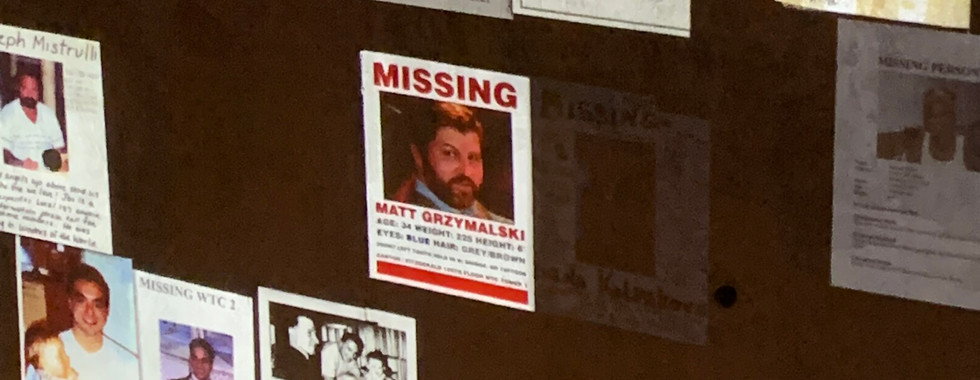Visiting the 9/11 Memorial Museum in Manhattan: A Comprehensive Guide
- Mark Vogel

- Jan 3, 2024
- 4 min read
Updated: Jul 29, 2024
New York City ✈

My visit to the 9/11 Memorial Museum in lower Manhattan was both profound and educational. In this article, I'll share insights from my experience, the history of the museum, details about its location and exhibits, and a visitor's guide to help you plan your visit.
The History of the Museum
The 9/11 Memorial Museum, officially opened on May 21, 2014, serves as a poignant tribute to the tragic events of September 11, 2001, and the 1993 World Trade Center bombing. It stands as a place of remembrance and a testament to resilience. The museum is built at the site of the former World Trade Center complex and is a part of the larger 9/11 Memorial, which includes the reflecting pools set within the footprints of the Twin Towers.
Buy Museum Tickets: 9/11 Memorial Museum Admission Ticket
“The 9/11 Memorial Museum is not just a museum; it's a place where history, personal stories, and the collective memory of a nation converge.”
Location
Situated in Lower Manhattan, the museum's entrance is located at 180 Greenwich Street. It's easily accessible by various means of transportation. The closest subway stations are the World Trade Center station (E train), Cortlandt Street (R train), and Fulton Street (multiple lines). For those driving, parking can be found in the surrounding area, though it is limited.

Architectural Design
- Reflective Design: The museum's design is deeply symbolic. The building is set below ground, descending visitors into the foundations of the original World Trade Center. This design choice creates a contemplative space that encourages reflection on the events of 9/11.
- Survivors' Stairs: An artifact of great significance is the "Survivors' Stairs," used by many people to escape the towers on 9/11. These stairs now stand as a symbol of survival and resilience.
The Exhibits
The museum's exhibits are both emotional and educational. They are designed to tell the story of 9/11 through multimedia displays, narratives, and a collection of artifacts. Key exhibits include:
- Historical Exhibition: This exhibit is divided into three parts: the events of the day, before 9/11, and after 9/11. It includes artifacts, photographs, and first-person accounts.
- Memorial Exhibition: Named "In Memoriam," this exhibit pays tribute to the 2,977 victims of the 9/11 attacks and the six victims of the 1993 World Trade Center bombing.
- Foundation Hall: A massive room with a portion of the surviving wall of the original World Trade Center. It also houses the "Last Column," a poignant reminder of the rescue and recovery efforts.
Interactive displays, narratives, and personal stories of loss, survival, and resilience are a significant part of the experience. The museum also offers educational programs and resources about the historical significance of the World Trade Center, 9/11, and its aftermath.

Art Installations
- Artwork: The museum features various art installations. One notable piece is Spencer Finch's "Trying To Remember the Color of the Sky on That September Morning," a wall of 2,983 individual watercolor squares - one for each victim - representing the color of the sky on September 11, 2001.
- Memorial Quilt: The museum also displays a quilt with patches contributed from people around the world as a tribute to the victims.
Educational and Cultural Significance
- Educational Programs: The museum conducts educational programs for students and teachers, including workshops, webinars, and teaching guides, aimed at understanding the historical context and impact of the events.
- Cultural Events: Regularly, the museum hosts cultural events, talks, and annual remembrances, making it a living part of the city's cultural landscape.
Visitor's Guide
- Hours: The museum is open daily. However, hours vary by season, so check the museum's website for current information.
- Tickets: It's advisable to purchase tickets in advance online to avoid long waiting lines. There are discounts for seniors, students, and veterans, and free admission on Tuesday evenings.
- Security: Expect airport-level security screening. Large bags are not permitted inside.
- Audio Guide: An audio guide, available in multiple languages, can enhance your experience.
- Respect and Sensitivity: Given the nature of the site, visitors are encouraged to maintain a level of decorum appropriate for a place of remembrance.

Visitor Experience
- Guided Tours: For those seeking a deeper understanding, the museum offers guided tours led by staff members who provide expert insights into the exhibits and the history of 9/11.
- Reflecting Absence: Outside, the 9/11 Memorial, titled "Reflecting Absence," includes two large waterfalls and reflecting pools set in the footprints of the Twin Towers. The names of every person who died in the 2001 and 1993 attacks are inscribed around the pools.
Commemorative Activities
- Anniversary Commemorations: Each year on the anniversary of 9/11, the museum plays a key role in the commemorative activities, including the reading of the names of those who died in the attacks.
Accessibility
- Accessibility: The museum is designed to be accessible to all visitors, including those with disabilities. Wheelchairs are available, and the exhibits are ADA compliant.
Online Resources
- Virtual Tour: For those unable to visit in person, the museum offers an extensive online presence, including a virtual tour and digital exhibitions, making its educational resources globally accessible.
The 9/11 Memorial Museum is not just a museum; it's a place where history, personal stories, and the collective memory of a nation converge. A visit here is a sobering experience, but it's also an important one for understanding a pivotal moment in recent history.
Buy Museum Tickets: 9/11 Memorial Museum Admission Ticket














































Comments